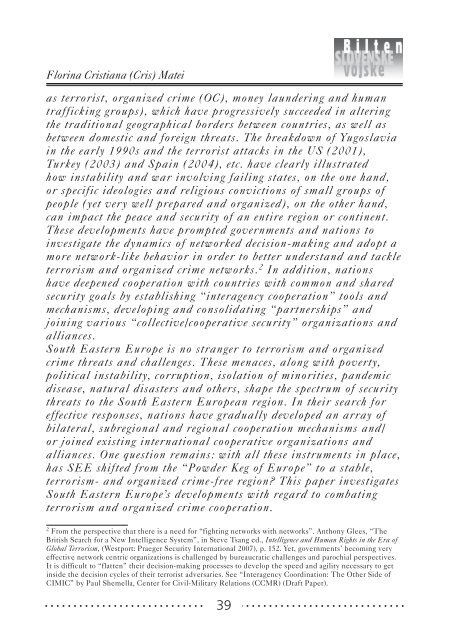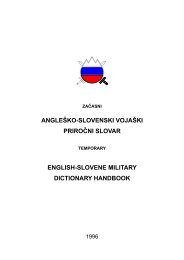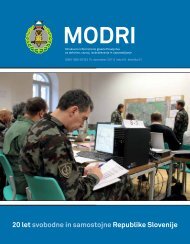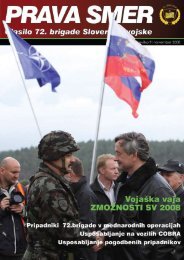bilten slovenska vojske.indd - Slovenska vojska
bilten slovenska vojske.indd - Slovenska vojska
bilten slovenska vojske.indd - Slovenska vojska
Create successful ePaper yourself
Turn your PDF publications into a flip-book with our unique Google optimized e-Paper software.
Florina Cristiana (Cris) Mateias terrorist, organized crime (OC), money laundering and humantrafficking groups), which have progressively succeeded in alteringthe traditional geographical borders between countries, as well asbetween domestic and foreign threats. The breakdown of Yugoslaviain the early 1990s and the terrorist attacks in the US (2001),Turkey (2003) and Spain (2004), etc. have clearly illustratedhow instability and war involving failing states, on the one hand,or specific ideologies and religious convictions of small groups ofpeople (yet very well prepared and organized), on the other hand,can impact the peace and security of an entire region or continent.These developments have prompted governments and nations toinvestigate the dynamics of networked decision-making and adopt amore network-like behavior in order to better understand and tackleterrorism and organized crime networks. 2 In addition, nationshave deepened cooperation with countries with common and sharedsecurity goals by establishing “interagency cooperation” tools andmechanisms, developing and consolidating “partnerships” andjoining various “collective/cooperative security” organizations andalliances.South Eastern Europe is no stranger to terrorism and organizedcrime threats and challenges. These menaces, along with poverty,political instability, corruption, isolation of minorities, pandemicdisease, natural disasters and others, shape the spectrum of securitythreats to the South Eastern European region. In their search foreffective responses, nations have gradually developed an array ofbilateral, subregional and regional cooperation mechanisms and/or joined existing international cooperative organizations andalliances. One question remains: with all these instruments in place,has SEE shifted from the “Powder Keg of Europe” to a stable,terrorism- and organized crime-free region? This paper investigatesSouth Eastern Europe’s developments with regard to combatingterrorism and organized crime cooperation.2From the perspective that there is a need for “fighting networks with networks”. Anthony Glees, “TheBritish Search for a New Intelligence System”, in Steve Tsang ed., Intelligence and Human Rights in the Era ofGlobal Terrorism, (Westport: Praeger Security International 2007), p. 152. Yet, governments’ becoming veryeffective network centric organizations is challenged by bureaucratic challenges and parochial perspectives.It is difficult to “flatten” their decision-making processes to develop the speed and agility necessary to getinside the decision cycles of their terrorist adversaries. See “Interagency Coordination: The Other Side ofCIMIC” by Paul Shemella, Center for Civil-Military Relations (CCMR) (Draft Paper).39
















